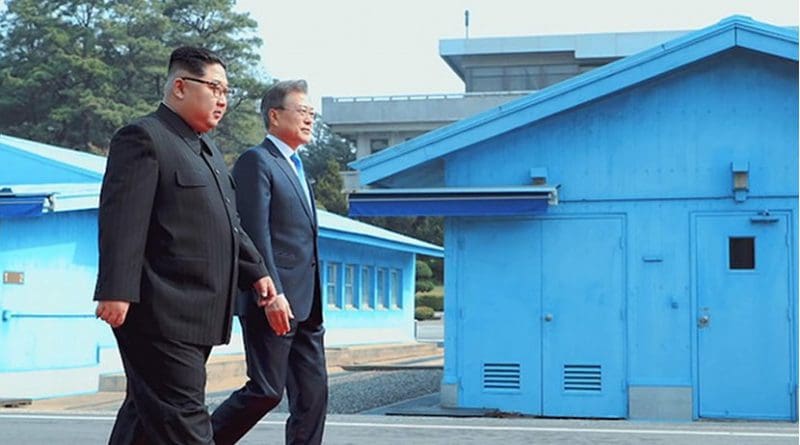Denuclearizing The Korean Peninsula: Hope Amidst Uncertainty? – Analysis
By IPCS
By Sandip Kumar Mishra*
In his mid-September visit to Pyongyang this year, South Korean President Moon Jae-in reportedly had several fruitful exchanges with North Korean leader, Kim Jong-un, culminating in the signing of the Pyongyang Joint Declaration. Both agreed to open permanent family reunion facilities in the short-term, work to reconnect cross-border rail and road links within this year, restart joint projects at Kaesong and Most Kumgang, and Kim’s visit to Seoul in 2018.
A military deal was signed between the South Korean Defence Minister Song Young-moo and North Korean First Vice Minister of the Ministry of the People’s Armed Forces No Kwang-chol. In this regard, they agreed to stop field training exercises and artillery drills in the border areas, and create buffer zones along the land and sea borders. They also decided to withdraw guard costs in the Demilitarised Zone completely. Both countries will pull out soldiers and military resources from 11 closely located posts in the border area by the end of this year. There are also an agreement about the joint excavation of the remains of Korean soldiers who died in the DMZ area during the Korean War, and creating a trilateral committee with the UN Command to demilitarise the Joint Security Area (JSA) at Panmunjom.
North Korea agreed to shut down its nuclear facilities at Yongbyon, work to make the Korean Peninsula nuclear weapons-free, and permanently shut down the Dongchang-ri missile engine test site. However, on these issues, North Korea has sought the US’ reciprocity. Further, there has been no announcement about the timeline or sequencing of the denuclearisation process. This means that Moon Jae-in was not able to achieve anything substantial on nuclear and missile issues, and resolution on the matter remains pending and subject to the US and North Korea. The overall conclusion is that Moon Jae-in narrowly focused on inter-Korea peace-building and left North Korea denuclearisation to the US. However, his visit was followed renewed US-North Korea engagement that began with the US Secretary of State Mike Pompeo’s visit to Pyongyang on 7 October. Pompeo has stated that “significant progress” was been made during his talks with Kim Jong-un and that the US and North Korea were “pretty close” to agreeing on the details of a second summit between Donald Trump and Kim Jong-un. There have since been reports that North Korea has agreed to open its nuclear test site, Punggye-ri as well missile engine site, Dongchang-ri to international inspectors. While this may not appear to be ‘significant progress’ to critics , it is important to underline that Pompeo was not even able to meet Kim during his last visit, and further estrangement between the US and North Korea was assumed. Developments seem to back on the right track, and Moon’s role in making it happen must not be overlooked or underplayed..
It is now incumbent on the US and North Korea to chart out the future course of denuclearisation in a way that is sensitive to each others’ expectations and limitations. Whereas the US would like to achieve some verifiable, concrete success first before easing out sanctions on North Korea, Pyongyang will demand simultaneous reciprocity. North Korean Foreign Minister Ri Yong-ho made this clear in his speech at the UN General Assembly on 29 September 2018, in which he emphasised ‘trust’ and ‘peace’ to move forward. Ri Yong-ho asked the US to first make some concessions to convince North Korea or its sincerity, and before they could begin denuclearising. He said, “…without any trust in the United States, there will be no confidence in our national security, and under such circumstances there is no way we will unilaterally disarm ourselves first.”
In the evening of the day of Ri’s speech, Trump said that after having exchanged letters with Kim, they had both fallen in “love” with each other. President Moon in fact made a very strategic visit to New York – to participate in the UNGA meeting, as well as to update Donald Trump about his recent trip to North Korea. Moon has been insisting that a peace treaty with North Korea must be concluded along with the re-initiation of various exchanges between the two Koreas, and delinking these processes from the process of denuclearisation.
Although that the US ostensibly seems to be following up on Moon’s efforts, there is a slowly emerging gap between Washington and Seoul about the speed and conditionality of engagement with Pyongyang. On 11 October, Trump sent a clear message to South Korea that it should not unilaterally lift sanctions imposed on North Korea – he said, “they (South Korea) do not do anything without our (the US) approval.”
That it is a time for cautious hope regarding developments on the Korean peninsula is clear. However, the US, South Korea and North Korea are all trying to move forward as per their own strategies, and there is still insufficient trust between these stakeholders. Amidst these uncertainties, the second Trump-Kim summit meet, tentatively scheduled after the US midterm election in November, will be an important milestone.

